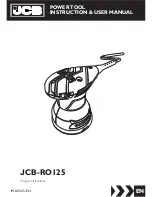
Safety
7
water solution. For removal of stubborn dirt such as road
tar, grease, and bug stains, you can use a mild ammonia
solution such as that used in glass cleaners. Before using
any cleaning product, check the label for recommended
applications and follow the directions for use.
Never apply cleaner directly onto surface to be polished.
Apply to a clean cloth then use the cloth to clean the
surface. Do not use any type of abrasive cleanser as it may
damage or scratch the surface.
INSTALLING/REMOVING APPLICATION BONNET
See Figure 4.
The reusable application bonnet is made of 100% terry
cloth and is used to apply polish to the painted surface.
■ To install: Place the power switch in the OFF (O)
position.
■ Remove battery pack from the tool.
■ Slip application bonnet edges over the top of the foam
pad.
■ To remove: pull bonnet edges over and off pad.
APPLYING POLISH TO THE APPLICATION BONNET
Most polishes are either in paste or liquid form. Before using
any polish, read all directions on appropriate applications
and proper use.
Applying paste polish
See Figure 5.
Use a putty knife or other flat, blunt object to apply
approximately one rounded teaspoon of paste onto the
bonnet. Evenly spread the paste over the entire surface
of the bonnet.
Do not apply paste directly to the surface being polished.
Applying liquid polish
See Figure 6.
Apply a small circle of liquid (about the size of a half-dollar)
around the center of the bonnet, followed by two more
rings, each slightly larger than the previous one. After the
first application, the bonnet will not absorb as much polish.
Apply two rings of polish to the bonnet for subsequent
applications, using half of the initial quantity.
WARNING
To prevent loss of control and possible serious personal
injury, always operate the tool with both hands, keeping
one hand on the handle.
APPLYING POLISH TO SURFACE
See Figure 7.
While holding the buffer/polisher firmly against the surface,
slide the ON/OFF switch to the ON position (to the left).
Always start and stop the polisher on or against the surface
being polished.
Begin by polishing larger flat surfaces, such as the hood,
trunk and roof. Use a broad sweeping motion in a crisscross
pattern. Do not press down on the surface with the polisher.
Let the orbital action of the pad and bonnet do the work.
Once flat surfaces have been covered, polish curved
surfaces such as car doors and quarter panels. Use small
circular motions.
After applying polish to the entire surface, turn buffer/
polisher off. Wait until the pad stops rotating before lifting
the buffer/polisher from the surface.
For hard-to-reach areas, such as the underside of bumpers
or side mirrors, apply polish by hand.
CHANGING TO BUFFING/POLISHING BONNET
See Figure 8.
WARNING
Check polishing bonnets before each use. Make sure
they are clean and free from any loose particles or
foreign objects that may be embedded in the bonnet.
Failure to do so could cause these particles or objects
to be thrown from the tool, resulting in possible serious
injury.
The reusable buffing/polishing bonnet is made of synthetic
tufted material and is used to buff and polish painted
surfaces.
Remove the battery pack from the buffer/polisher and
remove the application bonnet by loosening the drawstring
and slipping the bonnet off the pad. Replace with buffing/
polishing bonnet, attaching it the same way as the
application bonnet.
Buff the surface in the same order as it was polished,
starting with large flat surfaces and ending with hard-to
reach areas. Use the same motion as for polishing, a broad
sweeping criss-cross pattern on large flat areas and small
circular motions on all other areas. Remember to let the
tool do the work.
MAINTENANCE
WARNING
When servicing, use only identical replacement parts.
Use of any other part may create a hazard or cause
product damage.
GENERAL MAINTENANCE
Avoid using solvents when cleaning plastic parts. Most
plastics are susceptible to damage from various types of
commercial solvents and may be damaged by their use.
Use clean cloths to remove dirt, dust, oil, grease, etc.






























